NGOs rely on many funding sources, including government grants, corporations, foundations, and individual donors. While funders may have different perspectives, they all share the same goal: to help your NGO make an impact through its mission.
To keep driving your mission forward, you need to connect with all your donors and funders on a real level. You need to be able to show them the impact of their continued support and generosity. Those who have given before are likely to give more, especially if you can demonstrate the impact their funds have made.
Connecting with donors requires communication and engagement that makes an impact. In other words, you need to draw donors into the story of your mission. Show them the emotional side of how your organization helps. But don’t forget to demonstrate the real-world statistics about your organization’s outcomes and financial stewardship.
Let’s explore how to incorporate more of your organization’s story into donor communications. Here are three tips to make sure you tell stories that appeal to donors’ hearts and minds.
Tip 1: Craft your story to include financial performance data and outcome metrics
Donors and funders want to know two things before writing a check. First, will their contribution go toward a mission with meaning? And second, will the money they provide be used wisely and without waste?
If your organization has a modern, real-time financial management system in place, you should be able to demonstrate fiscal stewardship to donors. Further, if your financial management system shares data with other critical business systems such as grant management, CRM, etc., you can combine financial data (about program costs) with statistical data (about services delivered) to create outcome metrics. These metrics demonstrate both accountability and effectiveness. Therefore, they create a rich picture of performance for your donors.
World Learning shares outcome metrics everywhere—on their website, in social media, in funding campaigns, and their annual reports to donors. By managing financial performance and statistical data in their Sage Intacct cloud financial management system, they have real-time metrics to power their story. In the first example below, World Learning shows their resiliency and adaptability during the COVID-19 pandemic on their website. The second image shows COVID-related impact metrics within World Learning’s 2020 Impact Report. The final photo image shows how this NGO also utilizes metrics to tell stories via social media.
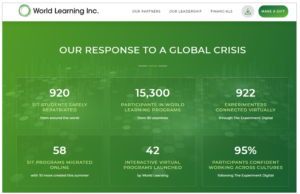
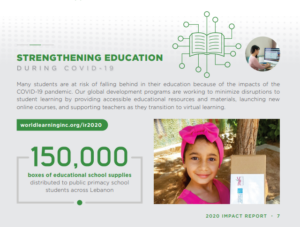
Tip 2: Choose images that connect on an emotional level
Is a picture worth a thousand words? One carefully selected image that grabs your donors’ attention can convey more than words — it lands on an emotional level. In today’s world, storytelling without video or images won’t connect effectively. So, visual storytelling needs to be part of your organization’s overall story.
Images can include photos and other visuals like charts and graphs. If you’re using photos and video, try to show the people you are helping and make the photos as active as possible. Whether you’re planting forests or digging wells or teaching literacy, show your volunteers and constituents working together to accomplish those things.
As you look for the right images for each campaign, keep one more tip in mind. Your visuals need to be consistent with your brand. Don’t be tempted to use humorous or tragic images if you don’t normally communicate that way. You want your donors (new and returning) to be able to identify and remember your organization and its mission. Use a writing style, colors, fonts, and graphic design templates that reinforce your brand.
The White Ribbon Alliance is an NGO dedicated to advancing reproductive, maternal, and newborn health rights. They use photographs and other visuals to tremendous effect on their website and social media channels. Notice how the banner photos on the website tell you exactly what type of work this organization engages in—without needing any words?

Next, look at this “Top Requests” page from their most recent annual report. White Ribbon Alliance has shown the needs of mothers both in numbers and photographs. The effect is powerful.
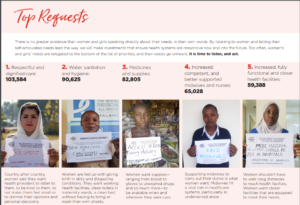
Finally, the following photographs tell a story within a story. The White Ribbon Alliance sponsored a “Stories of Mothers Lost” initiative. Women worldwide created powerful quilts that visualized stories of women who died in childbirth due to inadequate healthcare. The White Ribbon Alliance published a book, sponsored art exhibits, and created a Youtube video about these quilt stories.
Tip 3: Share your story across many channels
Since your organization serves many types of people in many locations around the world, it is vitally important that you share your mission story as widely as possible. Utilize as many different communication channels as you can.
A compelling website is a must for every NGO. Beyond that, expand your marketing channels to connect with more donors. For example, direct mail and email may work better with older generations of donors and in countries/locations that do not have consistent high-speed internet and mobile access. Younger donors are highly engaged by social media and will probably interact with your organization using a mobile device. Different parts of the world favor different social media platforms. Telling your story across varied different channels can be a challenge, but it will be worth it.
Room to Read visualizes the global nature of its impact on childhood literacy by displaying this map on their website. Also, on the website, they created a “Literacy Program Dashboard” showing donors the total impact the organization has made over time. On social media, Room to Read often shares stories about how their programs have impacted the lives of individuals or families, as you’ll see in the image below.
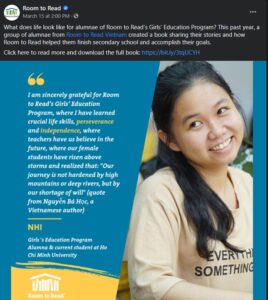
Bonus tip: Use this technique to show individual donors that small gifts make a big difference
When it comes to individual donations, NGOs tell the big story of their mission—often in terms of global need—but still find ways to help donors feel like every small donation can make a difference. NGOs can use financial and statistical data from their financial management system to help donors see exactly how much impact their donation can generate.
Children’s Hunger Fund uses real-time data from its Sage Intacct cloud accounting system to employ this technique on the donation page of their website. Knowing the exact amount spent per meal shows donors how just $12 can provide a Food Pak with 48 meals for children. When you can show so much impact for such a small contribution, it allows even the smallest donors to feel great about getting involved in your mission.
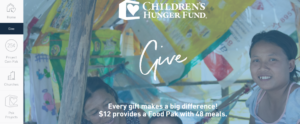
Learn more about NGO storytelling best practices
Nonprofits have important stories to tell and incorporating relevant, data-driven financial performance and outcome metrics greatly enhances those stories. If you would like to learn additional NGO storytelling best practices that demonstrate impact and connect with donors, catch up on the recorded webinar from May 11, From Good to Great – Elevating Your NGO’s Story with Data and Performance Metrics.

